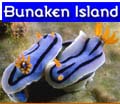

In
many ways, Fiordland's reefs seem richer and more full of life than
those in the warmer waters of the north. In shallow depths of often
no more than a few metres, I found tons of beautiful stuff to photograph.
The abundant tube anemones, large burrowing anemones, jewel anemones,
gorgonian fans and soft corals make excellent photographic subjects.
Many of these critters I'd never seen before and undoubtedly, there's
a lot more stuff that I didn't find.
 |
Fiordland's diving is perhaps best known for its black coral trees which occur in unusually shallow water for what is normally a deep water species. On the more spectacular walls, we found large trees festooned with snake stars and sometimes overgrown with collections of sponges, jewel anemones, soft corals, crinoids and ascidians.
 |
I didn't go beyond 25 metres on most dives but in many places, the walls drop almost vertically to what must be a very gloomy, almost lifeless world at 300 metres depth or more. In places you see big black coral trees way down below but there's big trees at much shallower depths and there hardly seems a need to go very deep.
 |
Fiordland has some interesting history, particularly with Cook's visit to Dusky Sound in 1773. Unfortunately, the weather and busy diving schedule in Dusky didn't allow us a chance to go ashore at any of the historic sites. Our picturesque anchorages at Sportsman's Cove and Luncheon Cove must have looked just as they did when Cook surveyed them over 200 years ago.
 |
In Luncheon Cove the dense forest almost completely surrounds the
tiny, sheltered cove. A group of young seals seem to have made this
place their home and frolicked around it's edge day and night, often
porpoising out of the water and seeming to leap over the low hanging
moss laden branches of the surrounding trees.
Near Luncheon Cove, the wreck of the Waikare is an excellent dive
in relatively shallow water. Dating from 1910, there's still lot
to see with parts of the wreck you can swim through and great potential
for fossicking.
 |
We did another dive in Breaksea Sound on a much more recent wreck
in considerably deeper water. This thing started to appear out of
the gloom at 30 metres or more and lured me down to the muddy bottom
beneath it at 60 metres where my throbbing brain lost all coherent
function.
The heavy lines connecting the wreck to a buoy on the surface would
have been worth a dive on their own with heavy growths of mussels
and dozens of different encrusting creatures.
 |
It's
very difficult to take photographs which capture the incredible ambience
of Fiordland. At its best, it's simply stunning. We experienced this
sort of gob smacking scenery towards the end on our trip in Doubtful
Sound.
After some relatively unfriendly weather in the first few days, we
did get a couple of days of good weather at the end. Having completed
our last dive in Acheron Passage, we decided to travel up the coast
to Doubtful Sound. From there, we planned to get picked up by chopper
from Deep Cove at the head of the sound the following day.
 |
The trip up the coast made the boat roll and lurch in a way that it hadn't for several days whilst in the protected waters of the sounds but the conditions were good for what must be a terrifying place during bad weather when enormous swells roll up from the Southern Ocean.
 |
In Doubtful Sound the mountains rise from the sea in a more dramatic way than they do in Dusky. In places, walls of rock climb almost vertically for several hundred metres and then continue further to snow covered peaks.
 |
Without a ripple on the surface, these dramatic peaks are reflected almost perfectly in the water which takes on an oily black appearance in the subdued light.
 |
As we made our way up Doubtful Sound towards our anchorage for the night at Olphert Cove, the feeble light of day was beginning to ebb and the breeze had almost completely exhausted itself.
 |
As the daylight disappeared, moonlight replaced it to maintain the reflection of the mountains in the now very oily black surface of the water. In the clear sky the white mountain peaks glowed by moonlight and stars filled the sky. Without a sound, without a breath of wind, the ambience was incredible.
Later that night I stirred as Greg came back from a nocturnal wander out on Sandpiper's rear deck. "It's amazing out there" he said.
And it was - utterly amazing!
 |
Top
side scenery amazing huh? Here's pics
from my 2003 trip to Doubtful Sound. And, here's 2004 Doubtful Sound pics.
© 2002 ianskipworth.com





